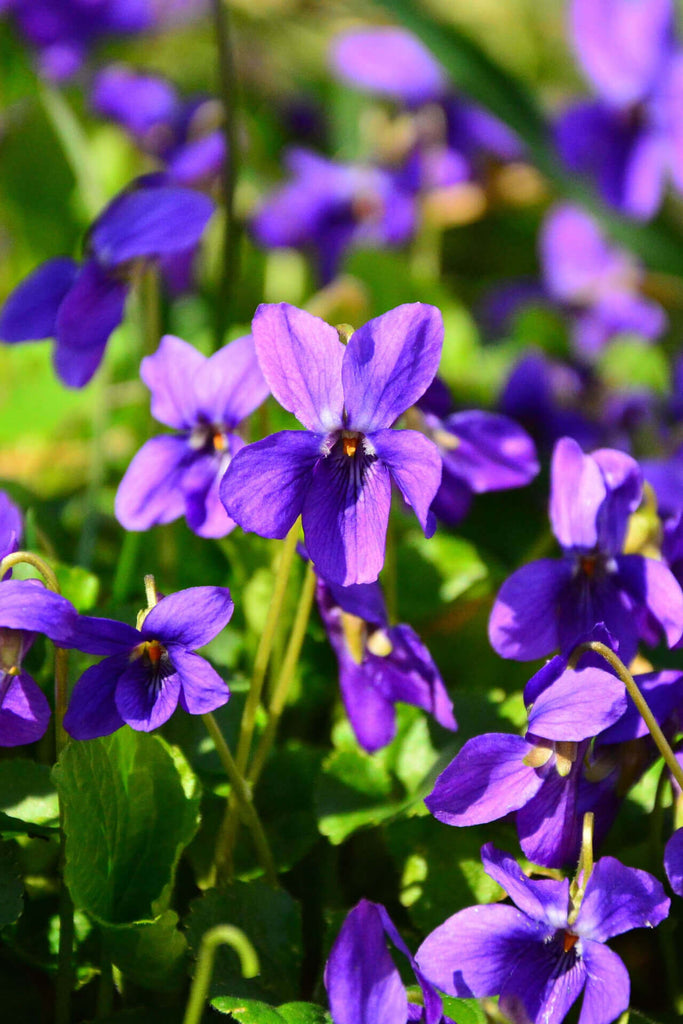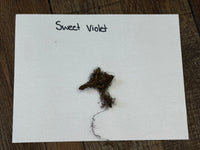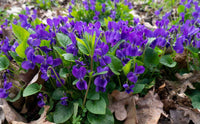




Couldn't load pickup availability
Ships in
7-10 DaysSweet Violet For Sale - Flowering Groundcover
Sweet Violet is the perfect carpet plant, with hundreds of deep purple flowers adorning the groundcover. It's pleasing to the eye with its purple flowers and dark green heart-shaped leaves. As harbingers of spring, these plants quickly emerge from the earth and bloom in the early spring months.
This plant adds a lovely, charming touch to your cottage garden, rock garden, or meadow garden, or even as an accent for your yard. When planted through grass the flowers appear like small purple dots studded throughout the landscape. Perfect in the shady border. For a modern take on this classic beauty, add it to raised areas of your garden that are at eye level or into a container for a truly pleasing display.
Sweet Violets are herbaceous perennials with vivid purple flowers.
Plant Details - Sweet Violet Plants
Family: Violaceae
Light Requirement: Full to Partial Shade
Water Needs: Moist
Height: 4 – 6 in.
Spread: 4 – 6 in.
Growth Rate: Fast
Bloom Time: Spring
Flower Color: Purple
Wildlife Value: Attracts bees and butterflies
Landscape Uses and Maintenance – Sweet Violet Plants
This plant will naturalize in the garden given the correct conditions. They grow very low to the ground and create an enticingly “sweet” groundcover you will enjoy year after year.
Plant it in an area with plenty of moist and well-draining soil. It thrives in full to partial shade. Pair it with Virginia bluebells, ferns, Bloodroot, and Dutchman’s Breeches for a beautiful and perennial spring display. Keep it moist and water when conditions are dry, especially in drought.
They can spread via underground rhizomes and by seed. Hop on by? Though uncommon, rabbits will eat violets without their preferred food sources, so watch out for these cute but hungry critters in your garden. However, this plant is deer resistant.
This plant will attract bees, moths, and butterflies to your garden. It attracts Fritillaries in particular.
Noteworthy Characteristics of Sweet Violet Plants
Sweet Violet flowers are sweetly scented, and they were once often pressed for perfume extraction or placed in sachets worn at the hip.They are a beloved plant and are the state flower for a few states, including New Jersey.
This Is How Your Plants Will Look upon Delivery

Bloom Season
Spring
Bloom/Foliage Color
Purple
Height at Maturity
Under 12"
Care
Sweet Violets thrive in well-drained soil. Keep them consistently moist but not waterlogged. In early spring, fertilize lightly with a balanced fertilizer. Remove spent flowers to encourage continuous blooming. Prune back after flowering to maintain shape and vigor.
Plant Reproduction
Sweet violet spreads quickly by short runners or can be propagated by seeds.
How to Grow and Care for Bare Root Perennials, Tubers, and Bulbs
Bare root perennials, tubers, and bulbs are an easy and economical way to jumpstart your garden with lasting beauty. These dormant plants should be planted in early spring or fall while the soil is cool and workable. Before planting, soak bare roots in water for 1–2 hours to rehydrate them. Choose a location based on the plant’s light needs—most flowering types prefer full sun, while others thrive in partial shade.
For bare root perennials, dig a shallow hole and spread the roots out naturally, ensuring the crown is level with the soil surface. For tubers and bulbs, plant with the pointed side facing up at a depth about two to three times their height. Cover with soil, gently press down, and water thoroughly.
Keep soil consistently moist (not soggy) until new growth appears. Add mulch to retain moisture and suppress weeds, but avoid covering the crown or bulb tops. Once established, these plants require little maintenance—just seasonal watering, occasional dividing, and deadheading or pruning as needed. With proper care, they’ll return and thrive year after year.
We carefully package every plant to retain superior moisture during transit. Once prepared, orders ship the same day through UPS or USPS, with typical delivery in 2–4 days.
Returns are not accepted, but plants are reshipped if extended warranty insurance was purchased at checkout. Otherwise, all plants include a standard 5-day warranty after delivery.




Caring Tips
How do I care for my Sweet Violet?
Each box contains detailed care instructions and information about your product. But here's the basics.
Care Tips
Sweet Violets thrive in well-drained soil. Keep them consistently moist but not waterlogged. In early spring, fertilize lightly with a balanced fertilizer. Remove spent flowers to encourage continuous blooming. Prune back after flowering to maintain shape and vigor.
Light Requirements
Sweet Violet thrives in partial to full shade, making it ideal for woodland gardens or shaded areas of your landscape. It can endure some morning sun, but too much natural sunlight can cause the leaves to scorch.
Hardy Planting Zones
5 • 6 • 7 • 8 • 9
The fragrance is classic and nostalgic. Planted near the path so we catch it every morning. Perfect in part shade with compost.
We noticed early bees working the blooms on sunny days. The patch is expanding steadily; easy to keep contained.
Classic cottage-garden look without the maintenance. A little mulch, regular watering, and they reward you every late winter.
First blossoms opened while the yard was still brown. Bees visited right away. Took off one star for slow shipping.
I tucked clumps beneath hydrangeas and they knit together nicely. A sprinkle of leaf mold kept moisture in and boosted growth.
